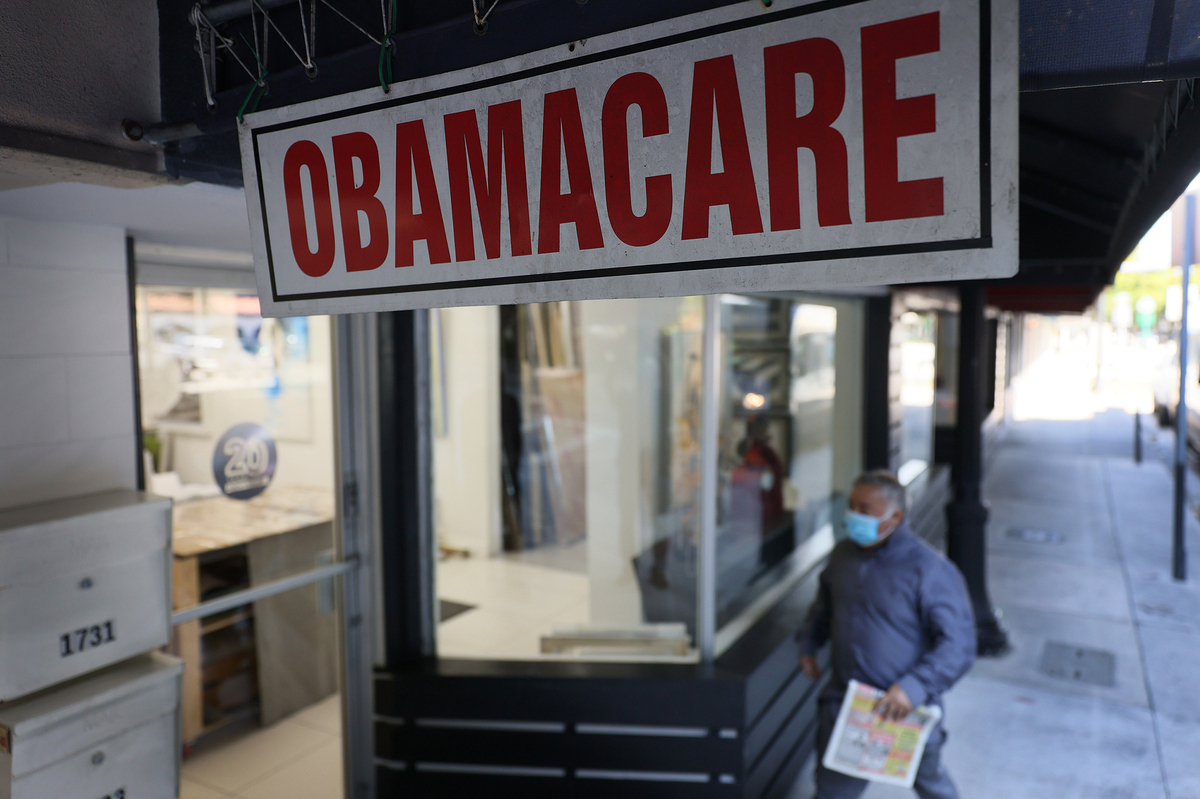[ad_1]
The recently passed $ 1.9 trillion COVID relief bill includes around $ 20 billion to make larger premium subsidies available to consumers who purchase qualified affordable care law plans.
Joe Raedle / Getty Images
hide caption
toggle legend
Joe Raedle / Getty Images

The recently passed $ 1.9 trillion COVID relief bill includes around $ 20 billion to make larger premium subsidies available to consumers who purchase qualified affordable care law plans.
Joe Raedle / Getty Images
When Democrats pushed through a two-year extension of the Affordable Care Act into the COVID-19 relief bill this month, many celebrated the part that will make health insurance more affordable for more. Americans.
But some healthcare researchers see the move as a short-term solution to a long-term crisis, one that avoids facing an uncomfortable truth: the only clear path to expanding Medicare still remains. no more government grants for commercial health plans, which are the most expensive form of coverage.
The ACA’s reliance on private plans – a hotly contested compromise in the 2010 Health Care Act that was meant to convince the industry – is already costing taxpayers tens of billions of dollars every year, as the federal government takes a share of insurance premiums for about 9 million Americans.
The price will now rise more due to the recently passed $ 1.9 trillion COVID relief bill. The law will allocate some $ 20 billion more to insurance companies by offering larger premium subsidies to consumers who purchase qualifying plans.


And if Democrats want to continue aid beyond 2022, when the extra aid from the relief bill runs out, the tab is sure to swell further.
“Expanding coverage is the path of least resistance,” said Paul Starr, a sociologist at Princeton University and leading authority on the history of health care in the United States, who called this “health policy trap” dynamic.
“Insurers have little to lose. Hospitals have little to lose. Pharmaceutical companies have little to lose,” observed Starr. “But the result is you end up adding to an incredibly expensive system.”
By next year, taxpayers will shell out more than $ 8,500 for every American receiving a subsidized health plan through the insurance markets created by the ACA, often referred to as Obamacare. That’s about 40% more than the cost of market subsidies in 2020, due to the increase in aid, data from the non-partisan Congressional Budget Office shows.
Supporters of the aid plan, known as the US Rescue Plan, argue that the federal government had to act quickly to help those in difficulty during the pandemic.

“That’s exactly why we pay taxes. We want the federal government to be there when we need it most,” said Mila Kofman, who heads the District of Columbia’s insurance market. Kofman said the midst of a pandemic was not the time to “wait for the perfect solution.”
But the important new government commitment highlights the disparity between the high price of private health insurance and lower-cost government plans like Medicare and Medicaid.
Recognizing this disparity, the artisans of the ACA charted a second path to providing health insurance to uninsured Americans alongside the markets: Medicaid.
Government’s half-century-old safety net insures about 13 million low-income, working-age adults who became eligible for the program through health legislation and who earn too little to qualify subsidized commercial insurance.
Medicaid coverage is always expensive: about $ 7,000 per person each year, according to federal data.
But that’s about 18% less than what the government will pay to cover people through commercial health plans.
“We knew it would cost less than subsidizing people to join private plans,” said former Rep. Henry Waxman, a California Democrat who, as chairman of the House Energy and Commerce Committee, contributed to the drafted the Affordable Care Act and has long championed Medicaid.
For patients, Medicaid offered another benefit. Unlike most commercial health insurances, which require registrants to pay large deductibles before their coverage takes effect, Medicaid severely limits the amount people have to pay for a doctor’s visit or trip to the hospital. ‘hospital.
This can have a huge impact on a patient’s finances.
Take, for example, a 50-year-old woman living outside of Phoenix with a part-time job paying $ 1,000 per month. With such a low income, the woman could enroll in Arizona’s Medicaid program.
If one day she slipped down her steps and broke her arm, her medical expenses would likely be fully covered, leaving her free of charge.
If the same woman found a full-time job that pays $ 4,000 a month but does not offer health benefits, she would still be able to get coverage, this time through a commercial health plan. in the Arizona insurance market.
Taxpayers would still bear part of the cost of his health plan, in this case about $ 300 per month, or half of the monthly premium of $ 606 for a basic silver level plan from health insurer Oscar. , according to a grant calculator from KFF, a nonprofit health policy. The woman will have to pay the remainder of the monthly premium.
Unlike Medicaid, however, its Oscar “Silver Saver” plan comes with a deductible of $ 6,200.
This means that the same arm broken as a result of his fall would likely leave him with medical bills exceeding $ 4,700, according to federal marketplace cost estimates Healthcare.gov.
The main reason commercial health plans cost more and burden patients with higher medical bills is that they typically pay hospitals, doctors, and other providers more than public programs such as Medicaid.
Often the price differences are dramatic.
For example, health insurers in the Atlanta area pay an average of $ 93 to primary care physicians for a basic patient visit, according to an analysis of 2017 commercial insurance data by the Health Care Cost Institute, a non-profit research organization.
In contrast, Georgia’s Medicaid program would pay the same doctor seeing a patient covered by the government’s health plan for just $ 41, according to the state’s fee schedule.
“It is much cheaper to provide health coverage to people through public programs like Medicaid than through private insurance, because the prices paid to doctors, hospitals and pharmaceutical companies are much lower,” said Larry Levitt, executive vice president of health policy for the Kaiser family. Foundation.
The disparity in prices also explains why the healthcare industry, including insurers and providers, fought for years proposals to create a new government plan, or “public option,” that could pay less.
Industry officials frequently argue that hospitals and doctors could not stay in business unless they charge higher prices to commercial insurers to offset the low prices paid by government programs.
The Biden administration and Congressional Democrats have so far avoided a battle over this issue by simply increasing subsidies to private health insurers.
KHN (Kaiser Health News) is a national newsroom that produces in-depth journalism on health issues. Together with Policy Analysis and Polling, KHN is one of the three main operational programs of KFF (Kaiser Family Foundation). KFF is an endowed nonprofit organization that provides information on health issues to the nation.
[ad_2]

